Radiation therapy is commonly used to treat patients with head and neck squamous cell carcinoma (HNSCC). One of the major side effects of radiotherapy is injury to the salivary glands (SG), which is thought to be mediated by microvascular dysfunction leading to permanent xerostomia. The goal of this study was to elucidate the mechanism of radiation-induced microvasculature damage and its impact on SG function. We measured bovine aortic endothelial cell (BAEC) apoptosis and ceramide production in response to 5 Gy irradiation, either alone or with reactive oxygen species (ROS) scavengers. We then investigated the effect of a single 15 Gy radiation dose on murine SG function. BAECs exposed to 5 Gy underwent apoptosis with increased ceramide production, both prevented by ROS scavengers. Among the 15 Gy irradiated mice, there was considerable weight loss, alopecia and SG hypofunction manifested by reduced saliva production and lower lysozyme levels. All of these effects, except for the lysozyme levels, were prevented by pretreatment with ROS scavengers. Microvessel density was significantly lower in the SG of irradiated mice compared to the control group, and this effect was significantly attenuated by pretreatment with Tempol. This study demonstrates that radiation-induced SG hypofunction is to a large extent mediated by microvascular dysfunction involving ceramide and ROS generation. These findings strongly suggest that ROS scavengers may serve as potential radioprotectors of SG function in patients undergoing radiotherapy for HNSCC.
How to translate text using browser tools
26 July 2016
Radiation-Induced Microvascular Injury as a Mechanism of Salivary Gland Hypofunction and Potential Target for Radioprotectors
Aviram Mizrachi,
Ana P. Cotrim,
Nora Katabi,
James B. Mitchell,
Marcel Verheij,
Adriana Haimovitz-Friedman
ACCESS THE FULL ARTICLE

Radiation Research
Vol. 186 • No. 2
August 2016
Vol. 186 • No. 2
August 2016




